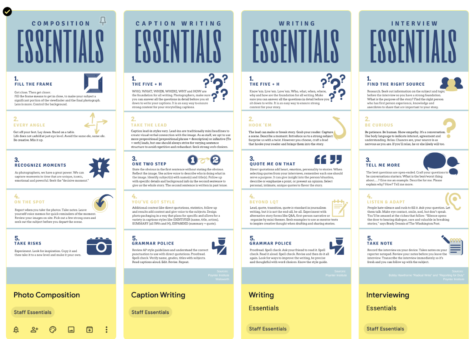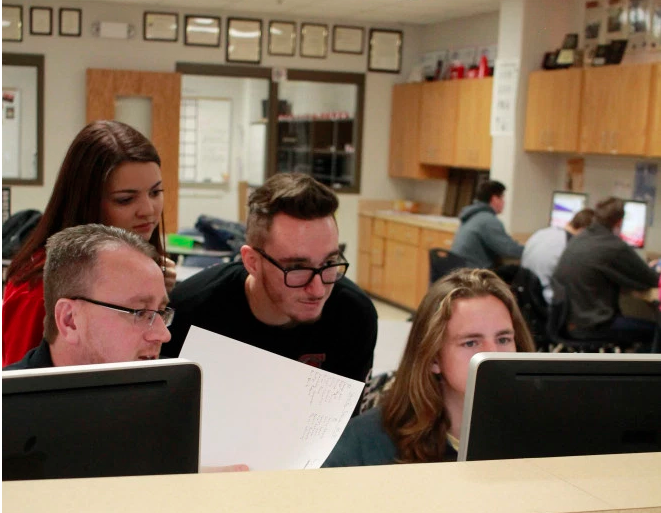Why A High School Journalism Class is Important
I had a teacher friend who writes for an education blog, visioninpracticeblog.wordpress.com, ask me to write about why a journalism class was important. Here’s what I shared with her.
I teach an elective course. More specifically, I teach journalism which includes advising the student yearbook, newspaper, photography, broadcast and more.
My favorite part of the school year is summer in-service when the district hires a presenter to get us all on board with “project-based learning.” Then I have to create a plan or present a group with a “real world” project in my classroom. I used to think they were kidding when they asked me about my plan. The $70,000 yearbook, online newspaper that’s updated daily, and photos and videos from every school event isn’t enough. I realized few people know or understand the importance of a successful high school journalism program.
The Newspaper Association of America did a study which proved high school journalism students perform better on standardized tests, make higher GPAs and earn higher grades their first semester of college than their classmates. So, again, why is a successful high school journalism program important?
Project Based
Our 320-page, all-color yearbook is a professionally printed book which is the only history document for the school. I realized the truth in this when a former student from Legacy High School played in the World Series. I had The New York Post, New York Times and two other New York publications ask for photos of Noah Syndergaard from his high school days, and we were not only the keepers of those photos but the reason they existed. We had them first.
The newspaper is an online-convergent media site that is updated daily and features stories, videos, photos, infographics, links, research, stats, and interviews. Students work together to keep the site updated each day—a constant deadline—with real stories and content that affect their readership. And it’s viewed by over 2,000 individual IP addresses a week from almost all 50 states. Who else’s homework is viewed that many times?
Everyday Skills
Writing. Photography. Communication. Ethics. Video. Web design. Videography. Interviewing. Fact gathering. Graphic Design. Marketing: All things learned in a journalism class. All things students will use almost daily in the future.
An Outlet for Core Classes
Writing. Grammar. Stats. Percentages. Sales. Social issues. Politics. Printing Mechanics. Interviewing. Communication. All of these are skills taught in the four core classes that we use weekly in a journalism class. Journalism is the outlet for the “how will we use this in the real world” questions students ask in core classes.
Work Flow
There are over 140 students in the Legacy Student Media program. They all have an issued email account (@therideronline.com, @legacystudentmedia.com or @legacybronco.tv). They all use Google Docs. Most are using WordPress for portfolios and managing the online newspaper’s content. Students are trained in procedures and format constantly throughout the year.
And it’s important to note that teenagers run this work flow. Every step is overseen by an editor or manager and none of them have a high school diploma, yet.
Communication Skills
Although they prefer to interview for a story over text or email, I force students to do face-to-face interviews. They also must set up appointments with adults they interview. They have to accurately take notes and keep up with a quote book. They have to fact check sources. They have to know how to be a professional. They learn the value of relationships in communications and are able to discern the appropriate time and place for technology.
Workplace Skills
What does an employer want from an employee? Analytical thinking. Peer Collaboration. Clear writing. Understanding of deadlines. This is the list of skills journalism teaches through hands-on experience. What about leadership and teamwork? Yep. Journalism is one of the few high school classes that accurately simulates a work environment – because it is one.
Time Management Skills
A story, video or photo gallery doesn’t just happen. Students learn to plan for the project. Not only are my journalism students at the top of their class, they are usually in other extracurricular activities. The JV drill team captain is on the yearbook staff. The backup varsity quarterback is a photo editor. The varsity boys forward on the basketball team is the sports editor. The JV baseball pitcher is a staff photographer. The student body president is our social media director. I could go on and on, but the point is that students in a journalism class have to juggle time and balance responsibilities.
Social Media and Marketing
A few months ago, we sat down and put all the rules we have for our department’s social media accounts on paper and created an in-depth policy, marketing plan, looked at our website’s Google Analytics to see the best time to hit our target audience and then sat down with the district’s communication department to align with their goals and policies. Students are learning how to be social media savvy in the workplace before they attend college. And let’s not forget that social media is one of the biggest job opportunities in the future.
The goal of scholastic journalism is not to create journalists, but rather it is to develop capable employees and engaged citizens. As a high school journalism teacher, I’m proud of those students who follow career journalism’s calling. I have former students working for newspapers, PR firms, social media/marketing firms, ESPN, the Texas Rangers and more.
But regardless if they pursue a career in journalism or communications, I know they will be more informed, more empathetic, well-rounded, strong communicators and more engaged as a result of their time in this elective course.
—Leland Mallett is the student media adviser at Legacy High School in Mansfield, Texas. The yearbook and newspaper (therideronline.com) have won numerous state and national awards. Leland is the webmaster for TAJE. contact: webmaster@taje.org or mallett@therideronline.com





